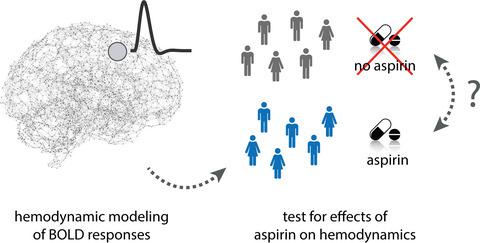当前位置:
X-MOL 学术
›
Eur. J. Neurosci.
›
论文详情
Our official English website, www.x-mol.net, welcomes your feedback! (Note: you will need to create a separate account there.)
Hemodynamic modeling of long‐term aspirin effects on blood oxygenated level dependent responses at 7 Tesla in patients at cardiovascular risk
European Journal of Neuroscience ( IF 3.698 ) Pub Date : 2020-09-16 , DOI: 10.1111/ejn.14970 Cao‐Tri Do 1 , Zina‐Mary Manjaly 2, 3 , Jakob Heinzle 1 , Dario Schöbi 1 , Lars Kasper 1, 4 , Klaas P. Pruessmann 4 , Klaas Enno Stephan 1, 5, 6 , Stefan Frässle 1
European Journal of Neuroscience ( IF 3.698 ) Pub Date : 2020-09-16 , DOI: 10.1111/ejn.14970 Cao‐Tri Do 1 , Zina‐Mary Manjaly 2, 3 , Jakob Heinzle 1 , Dario Schöbi 1 , Lars Kasper 1, 4 , Klaas P. Pruessmann 4 , Klaas Enno Stephan 1, 5, 6 , Stefan Frässle 1
Affiliation

|
Aspirin is considered a potential confound for functional magnetic resonance imaging (fMRI) studies. This is because aspirin affects the synthesis of prostaglandin, a vasoactive mediator centrally involved in neurovascular coupling, a process underlying blood oxygenated level dependent (BOLD) responses. Aspirin‐induced changes in BOLD signal are a potential confound for fMRI studies of at‐risk individuals or patients (e.g. with cardiovascular conditions or stroke) who receive low‐dose aspirin prophylactically and are compared to healthy controls without aspirin. To examine the severity of this potential confound, we combined high field (7 Tesla) MRI during a simple hand movement task with a biophysically informed hemodynamic model. We compared elderly individuals receiving aspirin for primary or secondary prophylactic purposes versus age‐matched volunteers without aspirin medication, testing for putative differences in BOLD responses. Specifically, we fitted hemodynamic models to BOLD responses from 14 regions activated by the task and examined whether model parameter estimates were significantly altered by aspirin. While our analyses indicate that hemodynamics differed across regions, consistent with the known regional variability of BOLD responses, we neither found a significant main effect of aspirin (i.e., an average effect across brain regions) nor an expected drug × region interaction. While our sample size is not sufficiently large to rule out small‐to‐medium global effects of aspirin, we had adequate statistical power for detecting the expected interaction. Altogether, our analysis suggests that patients with cardiovascular risk receiving low‐dose aspirin for primary or secondary prophylactic purposes do not show strongly altered BOLD signals when compared to healthy controls without aspirin.
中文翻译:

长期服用阿司匹林对有心血管风险的患者在7 Tesla下对血氧水平依赖性反应的长期影响的血流动力学模型
阿司匹林被认为是功能磁共振成像(fMRI)研究的潜在混淆。这是因为阿司匹林会影响前列腺素的合成,前列腺素是一种主要参与神经血管偶联的血管活性介体,是血液氧化水平依赖性(BOLD)反应的基础。阿司匹林诱导的BOLD信号变化可能是fMRI研究的潜在混淆因素,该研究针对的是高危人群或预防性接受低剂量阿司匹林的患者(例如患有心血管疾病或中风),并与没有阿司匹林的健康对照进行了比较。为了检查这种潜在混淆的严重性,我们在简单的手部运动任务中结合了高场(7特斯拉)核磁共振成像和生物物理信息的血流动力学模型。我们将接受阿司匹林用于主要或次要预防目的的老年人与未使用阿司匹林药物的年龄匹配志愿者进行了比较,测试了BOLD反应的假定差异。具体来说,我们将血液动力学模型拟合到任务激活的14个区域的BOLD响应,并检查阿司匹林是否显着改变了模型参数估计值。尽管我们的分析表明,血流动力学在不同区域之间存在差异,这与已知的BOLD反应区域差异一致,但我们既未发现阿司匹林的显着主要作用(即跨脑区域的平均作用),也未发现预期的药物×区域相互作用。尽管我们的样本量不足以排除阿司匹林的中小型全球影响,但我们有足够的统计能力来检测预期的相互作用。
更新日期:2020-09-16
中文翻译:

长期服用阿司匹林对有心血管风险的患者在7 Tesla下对血氧水平依赖性反应的长期影响的血流动力学模型
阿司匹林被认为是功能磁共振成像(fMRI)研究的潜在混淆。这是因为阿司匹林会影响前列腺素的合成,前列腺素是一种主要参与神经血管偶联的血管活性介体,是血液氧化水平依赖性(BOLD)反应的基础。阿司匹林诱导的BOLD信号变化可能是fMRI研究的潜在混淆因素,该研究针对的是高危人群或预防性接受低剂量阿司匹林的患者(例如患有心血管疾病或中风),并与没有阿司匹林的健康对照进行了比较。为了检查这种潜在混淆的严重性,我们在简单的手部运动任务中结合了高场(7特斯拉)核磁共振成像和生物物理信息的血流动力学模型。我们将接受阿司匹林用于主要或次要预防目的的老年人与未使用阿司匹林药物的年龄匹配志愿者进行了比较,测试了BOLD反应的假定差异。具体来说,我们将血液动力学模型拟合到任务激活的14个区域的BOLD响应,并检查阿司匹林是否显着改变了模型参数估计值。尽管我们的分析表明,血流动力学在不同区域之间存在差异,这与已知的BOLD反应区域差异一致,但我们既未发现阿司匹林的显着主要作用(即跨脑区域的平均作用),也未发现预期的药物×区域相互作用。尽管我们的样本量不足以排除阿司匹林的中小型全球影响,但我们有足够的统计能力来检测预期的相互作用。


























 京公网安备 11010802027423号
京公网安备 11010802027423号